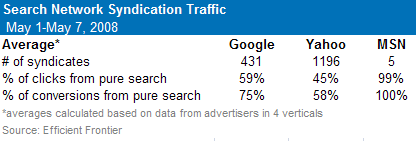Local businesses tend to be easy to service (because of limited competition), but tend to be hard to service profitably (due to big demands and small budgets).
Such companies are still spending billions of dollars advertising in yellow page directories across the United States because it is easy and flat rate. Search advertising makes advertising more granular and trackable, but most small businesses could not be bothered with it. While the dead tree advertising model is in decline…
Only the local interactive segment will show growth throughout the forecast period. All other local media will experience marginal to rapid declines in the next 18 to 36 months. A small number of traditional media will rebound with a revived economy beginning in 2011, though most traditional media will continue to decline, albeit at a slower pace.
…Google is looking to help transition small local business advertisers over to search by employing familiar flat rate advertising services, as highlighted in AdAge:
In a bid to get more local advertisers to buy search ads, starting this week Google is trying out a new type of search ad and pricing system in the San Francisco and San Diego markets.
Rather than ask businesses to set up a campaign and bid for keywords, they’re offering local advertisers (or non-advertisers) a search ad for a flat fee. The fee is set by Google and based on the average that similar businesses are paying for a given keyword in that market.
Lets go ahead and take one more look at that last sentence
The fee is set by Google and based on the average that similar businesses are paying for a given keyword in that market.
So Google is using your keywords and your bid prices to automate setting up accounts for competing businesses. You pay them for traffic and they arbitrage your efforts by using you as a free market research tool for competing businesses. And imagine if/when Google has 5 companies in your market all bidding based on the same flat fee average strategy. Some keyword prices could fluctuate wildly as the house decides to arbitrarily bid up or down a particular keyword or basket of related keywords.
In an earlier piece Mona Elesseily mentioned a recent Nick Fox keynote where he mentioned the idea of keyword-less paid search accounts, and how Google could run them:
Nick mentioned that keywords were used as a proxy for relevance. Conceptually, there is no reason an advertiser couldn’t achieve the same results without having to directly manage a keyword list. Down the road, Google wants to state outcomes and have machine-based learning and algorithms come up with the best method of achieving specific outcomes. In the case of no keyword search, an advertiser (like a retailer) would provide information on products, product descriptions, pricing, etc. and Google would use the information to find the most effective way to place ads in front of potential customers.
Those machine-based learning algorithms need input to become efficient. What happens if you share your conversion data with Google? This is one of the areas of opportunity on the web for 3rd party analytics providers. As Google continues to make advertising easier (and seemingly cheaper – at least up front) there will be added value in operating outside of their ecosystem and/or limiting how much data you hand over to the borg.
Presumably as this gets easier to automate and test it will increase the value of related services like website design and conversion testing (until those are automated and commoditized as well). But some smart business owners who enter the search game via these automated technologies will likely eventually want more granular control of their strategy, as it is hard to build a long lasting sustainable business based on market averages – especially when the fox is guarding the hen house. Over time those who evolve their model to increase lifetime customer value, increase conversion rates, and build distribution outside of search will eventually make the average price too expensive for an average business to be able to afford advertising.
Depending on how successful this test is, there are all kinds of implications for advertisers like…
- building and maintaining sustainable profit margins in an environment where machine learning algorithms see your max bids and work against you with every search and click
- deciding how much data to share with Google
- deciding if it makes sense to mix together multiple regions on 1 site to make it harder for search engines to use your campaign as a seed for competitors
- deciding if new business lines (and perhaps some longtail keywords) should be bid on for different websites that are not bidding on keywords associated with the obvious core industry keywords
And the general theme for online service providers is that if you are not thickening out your service prepared to be commoditized. Google does not need to create more value than you can, they only need to make businesses believe that you don’t add enough value to justify the additional expense, and that it is just easier for them to go with Google. Time to invest in brand building! Sometimes the SEO and PPC markets seem like mirror images. 😉





